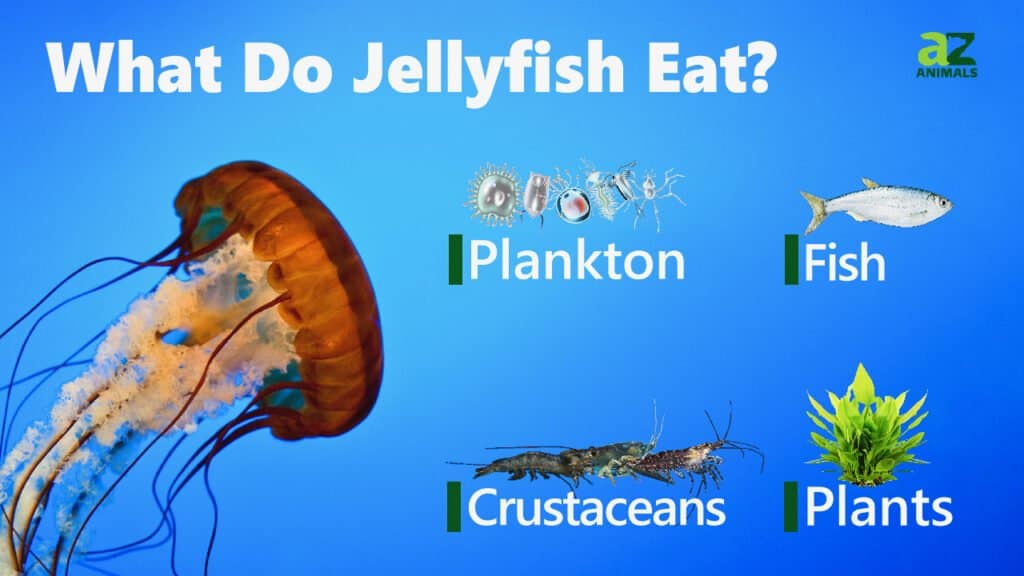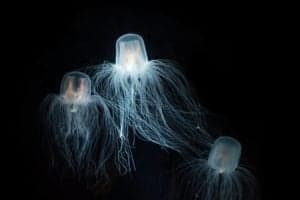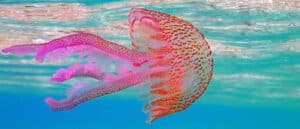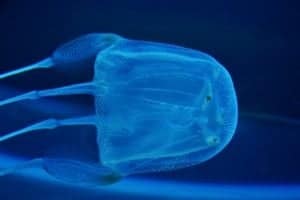Jellyfish are attractive, transparent, small, oval-like sea creatures that have lived for millions of years. In actuality, their entire lifecycle revolves around water, and this is practically true because jellyfish are about 95 percent water. They have tentacles used for hunting and are known for their stinging ability – a defense mechanism. Jellyfish have neither blood, heart, bone, brain, or other organs. They only consist of three layers: the outer layer known as the epidermis, a thick elastic and leased substance called mesoglea, and an inner layer called gastrodermis.
The Background on Jellyfish
Jellyfish are simple invertebrates that belong to the phylum Cnidaria, including sea anemones, Alcyonacea, and Coral. Incidentally, the body parts of a jellyfish radiate from the central axis, which allows them to recognize and respond to food and danger from all directions. A jellyfish can sting with tentacles, especially when it senses danger. The severity of stings varies; nonetheless, most jellyfish stings cause only slight discomfort to humans. They have tiny stinging cells on their tentacles that stun or paralyze their prey before eating it. Their bell-shaped body has an opening, which serves as a mouth and anus. Jellyfish eat and dispose of the waste from this opening, and they can live for up to three to six months and grow up to seven feet. In as much as they have all these fantastic attributes, several other sea creatures eat jellyfish daily.
What Eats Jellyfish?

Jellyfish are eaten by seabirds, turtles, and crabs.
©Vladimir Wrangel/Shutterstock.com
Grey triggerfish, ocean sunfish, seabirds, turtles, whale sharks, crabs, and whales eat jellyfish naturally. However, the main predators of jellyfish are usually other different types of jellyfish.
The jellyfish is a pelagic fish that lives in the open ocean from the tropics to the Arctic Ocean. Although it can move its umbrella rhythmically, it practically lives at the mercy of ocean currents. The jellyfish’s body exhibits radial symmetry and is divided into three main parts: an umbrella, the arm of the mouth (around the mouth), and a stinging tentacle. They are blessed with internal cavities where digestion takes place – amazingly, this cavity has a single opening that serves both the mouth and anus.
Jellyfish Predators: Ocean Sunfish
Sunfish are predators who eat various foods but their favorite delicacy is jellyfish. Since jellyfish are almost entirely water and low in calories and nutrients, fish as large as sunfish eat a significant amount of them to support their weight. These jellyfish predators are always on a hunting spree for these sea creatures because of their surprisingly high growth rate and weight which adds to their nutritional value.
Jellyfish Predators: Seabirds
Sea birds eat jellyfish by pecking their inner tissues to avoid their tentacles. Since jellyfish are 95 percent water, predators have to consume them in large amounts to get higher dietary nourishment.
Jellyfish Predators: Turtles

Turtles eat jellyfish without getting stung.
©iStock.com/MriyaWildlife
A jellyfish has long trailing tentacles full of stinging cells to ward off predators. However, the turtle still feeds on it without getting stung. Specific evolutionary adaptations/defense mechanisms have given turtles an edge over jellyfish’s stings. Interestingly, turtles have thick skin, especially around their beaks – protecting them from the excruciating pains of jelly stings. They also possess papillae that line their mouth, which helps them get a grip on their favorite meal and prevent prey from slipping.
Jellyfish Predators: Crabs

Crabs mostly eat dying jellyfish.
©Alexander Sviridov/Shutterstock.com
Because crabs live in the ocean depths, they often have difficulty accessing several jellyfish. They mostly feed on dying jellyfish. Surprisingly, the stinging cells of a jellyfish are unlikely to penetrate or interfere with the hard crab shell or mouthpiece.
Jellyfish are magnificent water creatures to behold. The lack of essential body organs common to other animals would leave one wondering how they survive and live their daily lives. Intriguingly, we have answers to some of these questions. So, let’s dive further as we unravel the surviving tactics of these water creatures and their habitat below:
What Do Jellyfish Eat?

Jellyfish are primarily carnivores. Astoundingly, when food is abundant in the ocean, they grow exponentially in size and breed in large numbers. However, food shortages always have a way of diminishing their sizes and procreating abilities. These gelatinous animals have elementary anatomy, but they are still very effective. Jellyfish mainly eat zooplankton, small crustaceans, and in some cases, small fish and other breeds of jellyfish.
How Jellyfish Reproduce
Male and female jellyfish reproduce by releasing sperm and eggs into the water (sexual reproduction). After fertilization, they develop larvae that produce new jellyfish and polyps that settle on the seabed. New free-living jellyfish can grow from these polyps through asexual reproduction.
How Jellyfish Defend Themselves
Jellyfish tentacles with stinging cells serve as a defense and a powerful weapon for catching prey. When in close range with their target, the nematocysts (poisonous cells) present in the tentacles release the harpoons and filaments, releasing toxic substances that paralyze their prey. Their oral arms help to catch and swallow the captured sea creatures.
Are Jellyfish Poisonous?
The complete lack of brain makes jellyfish sting at the slightest sense of danger. Jellyfish stings can be painful and sometimes dangerous to humans. However, jellyfish do not knowingly attack humans. For every one centimeter of its tentacles, a jellyfish has 3 million stinging cells. When a jellyfish’s stinging cells come in close contact with the human skin, it releases poison. Some possible effects of jellyfish poison include:
- Skin swelling or redness around the affected area
- Severe pains all over
- Experience difficulty in breathing, swallowing, and even talking
- Profuse sweating accompanied by shivering
- Experiencing headache, vomiting, nausea, and diarrhea
- Irregular pulse
Do Jellyfish Eat Other Fish?
Mostly, all jellyfish tend to be passive feeders, which implies that they feed on whatever comes their way as they are tossed from one place to another by ocean currents. Jellyfish practically eat whatever passes in the water and can fit well in their mouth, including krill, shrimp, and small fish.
The photo featured at the top of this post is © mishelo0/Shutterstock.com
Thank you for reading! Have some feedback for us? Contact the AZ Animals editorial team.






